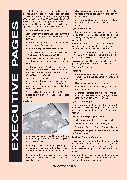EXECUTIVE PAGEScut on the bias so that it can be shaped to conform to the curve it will finish. Bias facings are often used on sheer fabrics to eliminate a wide facing that may show through. They are also used on children's gar- ments. A bias strip of lining fabric can eliminate heavy shaped facings on bulky fabrics. A bias fac- ing should be about 1/2 in. wide when finished. •Both shaped and bias facings can be cut from a fabric lighter in weight than the garment to re- duce bulk. •If you have to alter the pattern, be sure to alter facings and interfacings to match. •Interface a facing that will have buttonholes in it. •Make facings smooth and flat by clipping inward curves and notching outward curves. •Understitch shaped and extended facings to keep them from rolling to the outside of the gar- ment. • •It is commonly used in sewing to reinforce but- ton holes, stiffen collars and cuffs, and strength- en waistband. •Interfacing can be used in quilting to apply an applique, stabilize a lighter fabric, and prevent fraying. Types of Interfacing Tips For Applying Facings •• Finish outer edges of facings. Generally, the same finish that is applied to seams can be used to finish facing edges. Use the least bulky seam finish that will prevent raveling. Tack facings only at seams, such as the under- arm seam or side seam. Do not hand stitch the outer facing edge to the garment all the way around; this gives garments a puckered and un- professional look. Finish neckline facings over zippers. Then sew a hook and eye or flying snap to hold edges closed. InterfacingFusible: Convenient to use as there is a heat-acti- vated adhesive on one side. This can be ironed to the wrong side of your fashion fabric, giving com- plete contact. Sew In: Is ideal for fabrics with textures or that can't be ironed. It is meant to be sandwiched be- tween layers of fabric and sewn into place. Woven: Created from warp and weft fibers interwo- ven together. This type doesn't have any stretch, and will work well with any woven fabric. Nonwoven: Resembles fleece or felt. There isn't a grain line, and you can cut it in any direction. Trims and Fasteners Trimming •All the garments materials expect fabric required to make readymade garments are known as trimming. •It is attached in garment with sewing. •All types of trimmings are mainly used to fur- nishing garments. •Garments trimmings are attached to the gar- ments before and after finishing the garments in garments manufacturing technology. Types of Trimmings: There are two types of trimming .They are Visible trimming & Invisible trimming. Visible trims can be seen from outside of the garments. For example: interlining. Uses of Trimming in Apparel Industry: Trimming are used mainly two purposes such as- •Decoration: Example- Lace, Braid, Motif etc. •Functional: Example- Zipper, Button, Label etc. Different types of garments trimming are listed in the following table. •Interfacing is a material used to give additional strength, support or shape to sewing, quilting and crafts projects.Quality of Garments Trimming •Interfacing more like a Filler. It’s applied to parts of a garment to add extra body or rigidity, usual- ly offer more extra strength to the fabrics.Textile materials or non-textile materials are mainly used to make garments trimming. But they should be selected carefully to get desire performance from them. The important qualities of trimming are given below: •It is not intended to be visible in the finished project but is either sewn or fused to the wrong side of a fabric.Life time: If the trimmings become fade or break then garment will not be wearable. So life time of trims should be equal to garments. NCM-OCTOBER 2021 22
